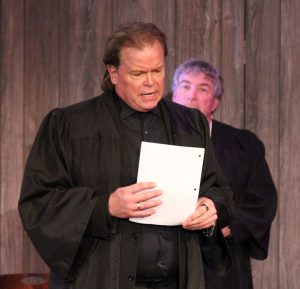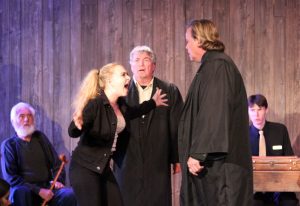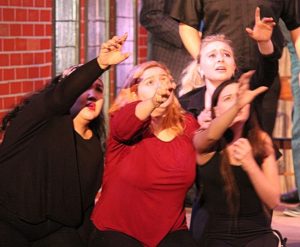Could ‘The Crucible’ happen all over again in 2019?
 All theater companies assay to include socially and politically relevant plays in their programming each season. Lab Theater especially takes this responsibility seriously, but who could have predicted that The Crucible would resonate so strongly in today’s socio-political climate or that the same factors that gave rise to the Salem witch trials would exist today?
All theater companies assay to include socially and politically relevant plays in their programming each season. Lab Theater especially takes this responsibility seriously, but who could have predicted that The Crucible would resonate so strongly in today’s socio-political climate or that the same factors that gave rise to the Salem witch trials would exist today?
Arthur Miller wrote the play to satirize the so-called McCarthy Trials –  proceedings brought before the House Committee on Un-American Activities in which Senator Joseph McCarthy ruined the careers of scores of people through the artifice of making unfounded and supported accusations that they were either Communists or Communist sympathizers. The trials occurred during a period known as the Red Scare,
proceedings brought before the House Committee on Un-American Activities in which Senator Joseph McCarthy ruined the careers of scores of people through the artifice of making unfounded and supported accusations that they were either Communists or Communist sympathizers. The trials occurred during a period known as the Red Scare,  when ordinary American citizens were in a panic over the possibility that Soviet spies (“the reds”) were living among us with nefarious plans to overthrow our democracy.
when ordinary American citizens were in a panic over the possibility that Soviet spies (“the reds”) were living among us with nefarious plans to overthrow our democracy.
McCarthy claimed to have a piece of paper with the names of 205 Communist party members. Thousands were investigated by the Committee and FBI. Those found guilty were blacklisted, fined, jailed and deported. Little evidence was  needed for an accused to be found guilty. One of the only ways to escape the charges was to sign and loyalty oath and provide the names of other suspected Communists.
needed for an accused to be found guilty. One of the only ways to escape the charges was to sign and loyalty oath and provide the names of other suspected Communists.
Unable to find a modern analogy for the play he wanted to write, Miller happened upon an historical two-volume study of the Salem witch trials  written by the Mayor of Salem in 1867. Today, the events that transpired in Salem between 1692 and 1693 are regarded by psychologists, sociologists and other scholars as a manifestation of mass psychogenic illness or “groupthink.”
written by the Mayor of Salem in 1867. Today, the events that transpired in Salem between 1692 and 1693 are regarded by psychologists, sociologists and other scholars as a manifestation of mass psychogenic illness or “groupthink.”
The latter term was coined in 1972 by a psychologist by the name of  Irving L. Janis, who published a book titled Victims of Groupthink: A Psychological Study of Foreign-Policy Decisions and Fiascoes. Janis postulated 8 attributes of this phenomenon, including (1) feelings of invulnerability; (2) belief in the rightness of their cause; (3) discrediting or explaining away anything that does not
Irving L. Janis, who published a book titled Victims of Groupthink: A Psychological Study of Foreign-Policy Decisions and Fiascoes. Janis postulated 8 attributes of this phenomenon, including (1) feelings of invulnerability; (2) belief in the rightness of their cause; (3) discrediting or explaining away anything that does not  conform to their own thinking; (4) negatively stereotyping rivals; (5) censuring or ostracizing dissenters; (6) pressuring members to withhold opinions that run contrary to group’s consensus; (7) the false belief that everyone in the group is in agreement with the leader(s); and (8) the appointment of “mind guards” who protect the group from adverse information that might threaten group cohesiveness and complacency.
conform to their own thinking; (4) negatively stereotyping rivals; (5) censuring or ostracizing dissenters; (6) pressuring members to withhold opinions that run contrary to group’s consensus; (7) the false belief that everyone in the group is in agreement with the leader(s); and (8) the appointment of “mind guards” who protect the group from adverse information that might threaten group cohesiveness and complacency.
 Remarkably, Arthur Miller anticipated this analysis. Each of these symptoms of groupthink can be found in The Crucible.
Remarkably, Arthur Miller anticipated this analysis. Each of these symptoms of groupthink can be found in The Crucible.
In the extreme, groupthink sets the predicate for mass hysteria, and examples of the latter date back to the Middle Ages. For example, in 1518, a woman in Strasbourg, France stepped into a street and began dancing. She was joined in the ensuing days by more than 400 people.  By the time the Dancing Plague of 1518 ended, dozens of dancers had died of heart attacks, strokes and exhaustion.
By the time the Dancing Plague of 1518 ended, dozens of dancers had died of heart attacks, strokes and exhaustion.
Before you scoff, you should know that Johns Hopkins University School of Hygiene and Public Health has documented at least 70 distinct outbreaks of mass hysteria between 1973 and 1993 alone.  Of these, 34 occurred in the United States. But short of mass hysteria, groupthink is believed to lie at the heart of such events as the failure to prepare for the attack on Pearl Harbor, the Bay of Pigs invasion, the ramp up of the Vietnam War, the Watergate cover-up, the decision to launch the space shuttle Challenger, the Iran-Contra affair and the Enron scandal.
Of these, 34 occurred in the United States. But short of mass hysteria, groupthink is believed to lie at the heart of such events as the failure to prepare for the attack on Pearl Harbor, the Bay of Pigs invasion, the ramp up of the Vietnam War, the Watergate cover-up, the decision to launch the space shuttle Challenger, the Iran-Contra affair and the Enron scandal.
Could it also be  at the heart of the current situation involving the alleged extortion of the President of Ukraine, its cover-up and the ensuing whistleblower complaint?
at the heart of the current situation involving the alleged extortion of the President of Ukraine, its cover-up and the ensuing whistleblower complaint?
Although he could not have predicted it, Arthur Miller would not be surprised in the least to learn that the same kind of circumstances that play out in The Crucible or McCarthyism could recur. And all 8 indicia of groupthink can be found to exist in the White House today – from an unshakable belief in  the President’s invincibility and negatively stereotyping opponents to purging the group of dissenters and advisors who hold contrary opinions. Ironically, the term “witch hunt” is used to label those who display the temerity to investigate or question their decisions or motivations – or, harkening back to McCarthy’s days, they accuse outspoken opponents as “spies,” “traitors”
the President’s invincibility and negatively stereotyping opponents to purging the group of dissenters and advisors who hold contrary opinions. Ironically, the term “witch hunt” is used to label those who display the temerity to investigate or question their decisions or motivations – or, harkening back to McCarthy’s days, they accuse outspoken opponents as “spies,” “traitors”  and purveyors of “fake news.”
and purveyors of “fake news.”
If a form of groupthink is going on within the Trump Administration, we could be on the precipice of a new outbreak of mass hysteria on a magnitude of the Salem witch trials.
As a group’s cohesiveness increases, so does its susceptibility to groupthink and mass hysteria, with the trigger  for the latter phenomenon being a shared fear that spirals into paranoia and ultimately panic. With group members feeding off each other’s emotional reactions, paranoia and panic escalate exponentially.
for the latter phenomenon being a shared fear that spirals into paranoia and ultimately panic. With group members feeding off each other’s emotional reactions, paranoia and panic escalate exponentially.
The key is identifying the relevant group. For instance, it would be a gross exaggeration to think that everyone who supports the President believes that asylum seekers are part of a marauding army that’s illegally invading the United States, those who  belong to subsets of the President’s supporters such as White Supremacists may. And thus the Pittsburgh synagogue shooting or the massacre in El Paso can be viewed as manifestations of groupthink on a more isolated but equally violent magnitude.
belong to subsets of the President’s supporters such as White Supremacists may. And thus the Pittsburgh synagogue shooting or the massacre in El Paso can be viewed as manifestations of groupthink on a more isolated but equally violent magnitude.
The Crucible teaches that when an outside threat (girls falling  into a catatonic state) increases fear within a group (accusations of witchcraft), panic can set in which culminates in dire and widespread consequences not only within the group, but the larger community in which it exists.
into a catatonic state) increases fear within a group (accusations of witchcraft), panic can set in which culminates in dire and widespread consequences not only within the group, but the larger community in which it exists.
While most episodes of groupthink and mass hysteria are fairly small, several have involved thousands of people, such as the panic caused on Halloween in 1938  by Orson Welles’ War of the Worlds radio broadcast. (While some believe that the number of people actually affected was only in the hundreds, most sources, including PBS and NPR, indicate that thousands of people called radio stations, the police and newspapers and scores in New England loaded up their cars and fled their homes.)
by Orson Welles’ War of the Worlds radio broadcast. (While some believe that the number of people actually affected was only in the hundreds, most sources, including PBS and NPR, indicate that thousands of people called radio stations, the police and newspapers and scores in New England loaded up their cars and fled their homes.)
And while most cases of mass hysteria are short lived,  the Salem witch trials spanned more than a year and the Tanganyika Laughter Epidemic of 1962 continued for more than 18 months.
the Salem witch trials spanned more than a year and the Tanganyika Laughter Epidemic of 1962 continued for more than 18 months.
The Crucible teaches other lessons that hold true today. From the example of Reverend John Hale (who can be viewed as a stand-in for the media and the scientific community) we see that research, facts and analysis don’t trump firmly-entrenched groupthink because groupthink, by its very nature, discredits or explains  away anything that does not conform to the group’s beliefs or way of thinking. And when it comes to the preservation or aggregation of power, the legal system (represented by Deputy Governor Danforth, Judge Hawthorne, Marshal Herrick) can not only be corrupted, it can also succumb to groupthink.
away anything that does not conform to the group’s beliefs or way of thinking. And when it comes to the preservation or aggregation of power, the legal system (represented by Deputy Governor Danforth, Judge Hawthorne, Marshal Herrick) can not only be corrupted, it can also succumb to groupthink.
Is The Crucible a harbinger of things to come? Was Artistic  Director Annette Trossbach and her selection committee being prescient when they negotiated for the rights to produce the play?
Director Annette Trossbach and her selection committee being prescient when they negotiated for the rights to produce the play?
Perhaps not.
But still I challenge you to bear these thoughts in mind as you watch the play unfold on the Lab Theater stage. The ingredients are all there – a new threat from the outside (impeachment resulting from the behavior alleged in the whistleblower  complaint). A charismatic and persuasive leader who stereotypes, reviles and threatens outside parties or groups. Mind guards like the Fox News hosts, Senate leaders like Lindsay Graham and Mitch McConnell, and an Attorney General that acts eerily like Deputy Governor Danforth.
complaint). A charismatic and persuasive leader who stereotypes, reviles and threatens outside parties or groups. Mind guards like the Fox News hosts, Senate leaders like Lindsay Graham and Mitch McConnell, and an Attorney General that acts eerily like Deputy Governor Danforth.
So ask yourself: could a groupthink such as this spawn a new crucible or mass hysteria on an unprecedented,  social-media-fueled level?
social-media-fueled level?
See The Crucible and decide for yourself.
The Crucible runs at Lab Theater through October 12.
September 26, 2019.
RELATED POSTS.
 Lab Theater marks 100th production with ‘The Crucible’
Lab Theater marks 100th production with ‘The Crucible’- Lab’s ‘Crucible’ product of savvy direction, inspired production and break-out performances
- ‘Crucible’ play dates, times and ticket info
- Spotlight on actor Steven Coe
- Spotlight on actor Paul Graffy
- Spotlight on actor Imani Lee Williams
 Spotlight on actor Kinley Gomez
Spotlight on actor Kinley Gomez- Spotlight on actor Isabel Isenhower
- Spotlight on actor TJ Albertson
- Spotlight on actor Todd Lyman
- Spotlight on actor Lauren Miller
- Spotlight on actor Heather McLemore Johnson
- Spotlight on actor Mike Dinko
- Spotlight on actor Melanie Payne














 Tom Hall is both an amateur artist and aspiring novelist who writes art quest thrillers. He is in the final stages of completing his debut novel titled "Art Detective," a story that fictionalizes the discovery of the fabled billion-dollar Impressionist collection of Parisian art dealer Josse Bernheim-Jeune, thought by many to have perished during World War II when the collection's hiding place, Castle de Rastignac in southern France, was destroyed by the Wehrmacht in reprisal for attacks made by members of the Resistance operating in the area. A former tax attorney, Tom holds a bachelor's degree as well as both a juris doctorate and masters of laws in taxation from the University of Florida. Tom lives in Estero, Florida with his fiancee, Connie, and their four cats.
Tom Hall is both an amateur artist and aspiring novelist who writes art quest thrillers. He is in the final stages of completing his debut novel titled "Art Detective," a story that fictionalizes the discovery of the fabled billion-dollar Impressionist collection of Parisian art dealer Josse Bernheim-Jeune, thought by many to have perished during World War II when the collection's hiding place, Castle de Rastignac in southern France, was destroyed by the Wehrmacht in reprisal for attacks made by members of the Resistance operating in the area. A former tax attorney, Tom holds a bachelor's degree as well as both a juris doctorate and masters of laws in taxation from the University of Florida. Tom lives in Estero, Florida with his fiancee, Connie, and their four cats.